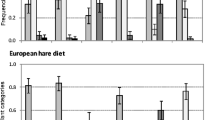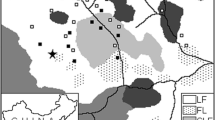Summary
-
1.
Two geographically adjoining but allopatric and altitudinally disjunct species (nothra and anchidiphalara) of the forest grasshopper genus Rhachicreagra were compared for food plant preferences in the laboratory. It has been shown that both are oligophagous and that their natural diets are markedly different. Both were offered the same 8 foodplants in a matrix of 2-way choice experiments. These plants included all important constituents of the natural diets of both species.
-
2.
The resultant preference rank order was virtually identical for the two species, suggesting that the proportions of the different plants in the natural diet are determined principally by their relative availability.
-
3.
The only major differences between the rank orders of the two species arise from the fact that both show an increased preference (relative to the other species) for the commonest foodplant in their own habitat. Indirect evidence suggests that this is the result of evolutionary change, not of conditioning during the lifetime of the individual.
-
4.
There is no suggestion that host plant switching has played any significant role in speciation within the genus.
Similar content being viewed by others
References
Bush GL (1974) The mechanism of sympatric host race formation in the true fruit flies. In: White MJD (ed) Genetic mechanisms of speciation in insects. Sydney, Australian and New Zealand Book Co, pp 3–23
Ehrlich PR, Raven PH (1964) Butterflies and plants: a study in coevolution. Evolution 18:586–608
Harris P (1972) Food-plant groups of the Semanophorinae (Lepidoptera: Sphingidae): a possible taxonomic tool. Can Entomol 104:71–80
Hering M (1951) Biology of the leafminers. 's-Gravenhage, Dr. W. Junk
Herrebout WM, Kuitjen PJ, Wiebes JT (1976) Small ermine moths of the genus Yponomeuta and their host relationships (Lepidoptera, Yponomeutidae). Symp Biol Hung 16:91–94
Jago ND, Rowell CHF (1981) Rhachicreagra (Acrididae, Ommatolampinae): forest grasshoppers from Central America with unique aedeagal symmetry. Syst Entomol 6:179–212
John B (1984) The role of chromosome change in the evolution of orthopteroid insects. In: Sharma AK, Sharma AS (eds) Chromosomes in the evolution of Eukaryotes. CRC Press, Florida, pp 1–110
John B, King M (1982) Meiotic effects of supernumary heterochromatin in Heteropternis obscurella. Chromosoma 85:39–65
John B, King M (1983) Population cytogenetics of Atractomorpha similis. I. C-band variation. Chromosoma 88:57–88
John B, Lightfoot DC, Weissman DB (1983) The meiotic behaviour of natural F1 hybrids between Trimerotropis suffusa Scudder and T. cyaneipennis Bruner (Orthoptera: Oedipodinae). Can J Genet Cytol 25:467–477
Mesa A, Ferreira A (1977) Cytological studies in the family Ommexechidae (Orthoptera: Acridoidea). Acrida 6:261–272
Mesa A, Ferreira A (1978) The chromosomes of South American Eumastacids (Orthoptera: Eumastacidae) and a discussion of the phylogeny of the family. Acrida 7:157–163
Mesa A, Ferreira A (1981) Do the Australian Morabinae and the neotropical Proscopiidae evolve from a common ancestor? A cytogenetical point of view (Orthoptera: Caelifera, Eumastacoidea). Acrida 10:205–218
Pasteels JM, Rowell-Rahier M, Braekman J-C, Daloze D (1984) Chemical defences in leaf beetles and their larvae: the ecological, evolutionary and taxonomic significance. Biochem Syst Ecol 12:395–406
Rehn JAG (1905) A contribution to the knowledge of the Acrididae (Orthoptera) of Costa Rica. Proc Acad Nat Sci Philadelphia 67:400–454
Rentz DCF, Weissman DB (1984) Five new species of the bandwinged grasshopper genus Trimerotropis Stål (Orthoptera: Oedipodinae). Pan-Pacific Entomol 60:227–237
Rowell CHF (1978) Foodplant specificity in neotropical rain-forest acridids. Entomol Exp Appl 24:651–662
Rowell CHF (1985) The feeding biology of a species-rich genus of rain-forest grasshoppers (Rhachicreagra, Orthoptera, Acrididae). I. Food plant use food plant. Oecologia (Berlin) 68:87–98
Rowell CHF, Rowell-Rahier M, Braker HJ, Cooper-Driver G, Gomez LD (1984) The palatability of forns and the ecology of two tropical grasshoppers. Biotropica 15:207–216
Rowell-Rahier M (1984) The foodplant preferences of Phratora vitellinae (Coleoptera: Chrysomelinae). B. A. laboratory comparision of geographically isolated populations and experiments on conditioning. Oecologia 64:375–380
Shaw DD, Wilkinson P, Coates DJ (1984) Increased chromosomal mutation rate after hybridization between two subspecies of grasshoppers. Science 220:1165–1167
Singer MC (1983) Determinants of multiple host use by a phytophagous insect population. Evolution 37:389–403
Sokal RR, Rohlf FJ (1969) Biometry: the principles and practice of statistics in biological research. WH Freeman & Co, San Francisco, p 776
Stanley SM (1979) Macroevolution: pattern and process. WH Freeman & Co, San Francisco, p 332
White MJD (1973) Animal cytology and evolution, 3rd ed. Cambridge University Press, New York
White MJD (1978) Modes of speciation. WH Freeman & Co, San Francisco, p 455
Zwoelfer H (1974) Das Treffpunkt-Prinzip als Kommunikations-strategie und Isolationsmechanisus bei Bohrfliegen (Diptera: Trypetidae). Entomol Germ 1:11–20
Author information
Authors and Affiliations
Rights and permissions
About this article
Cite this article
Rowell, C.H.F. The feeding biology of a species-rich genus of rainforest grasshoppers (Rhachicreagra, Orthoptera, Acrididae). Oecologia 68, 99–104 (1985). https://doi.org/10.1007/BF00379480
Received:
Issue Date:
DOI: https://doi.org/10.1007/BF00379480




